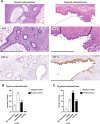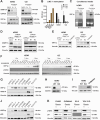LINE-1 ORF1p expression occurs in clear cell ovarian carcinoma precursors and is a candidate blood biomarker
- PMID: 40050409
- PMCID: PMC11885553
- DOI: 10.1038/s41698-025-00849-1
LINE-1 ORF1p expression occurs in clear cell ovarian carcinoma precursors and is a candidate blood biomarker
Abstract
Long interspersed element 1 (LINE-1) retrotransposons are repetitive sequences that can move within the genome by an autonomous mechanism. To limit their mutagenic potential, benign cells restrict LINE-1 expression through molecular mechanisms such as DNA methylation and histone modification, but these mechanisms are usually impaired in cancer. Clear cell ovarian carcinoma (CCOC) represents 5-10% of ovarian cancers and is thought to arise from endometriosis. Women with advanced CCOC face poor prognoses, highlighting the importance of understanding early disease pathogenesis. In our study, 33 of 40 cases (over 82%) of CCOC tumors express ORF1p, a LINE-1-encoded protein. We found that LINE-1 de-repression is an early event in CCOC, as ORF1p is enhanced during the transition from typical to atypical endometriosis and persists in invasive cancer. Finally, using single-molecule array (Simoa) assays, we detected ORF1p in patient blood, suggesting it as a potential minimally invasive biomarker for this disease.
© 2025. The Author(s).
Conflict of interest statement
Competing interests: D.R.W. has a financial interest in Quanterix Corporation, a company that develops an ultra-sensitive digital immunoassay platform. He is an inventor of the Simoa technology, a founder of the company, and also serves on its Board of Directors. D.R.W.’s interests were reviewed and are managed by Brigham and Women’s Hospital and Partners Healthcare in accordance with their conflict of interest policies. A.K.G. is a co-founder of Sinochips Diagnostics, serves as a scientific advisory board member to Biovica, Clara Biotech, EXOKĒRYX, VITRAC Therapeutics, and Sinochips Diagnostics, and receives research funding from Predicine and VITRAC Therapeutics. R.D. serves on the scientific advisory board of Repare Therapeutics. All other authors declare no financial or non-financial competing interests.
Figures





References
Grants and funding
LinkOut - more resources
Full Text Sources
Research Materials

